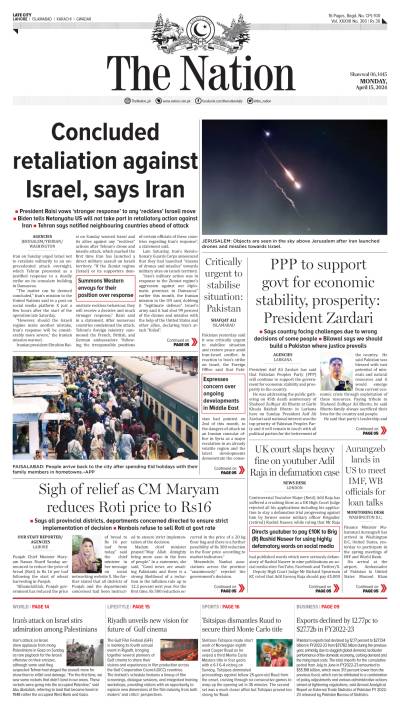WASHINGTON - The Pentagon is poised to ramp up its withdrawal of military equipment from Afghanistan in a massive logistics effort expected to cost up to $7 billion, a defence official said.
The US military is planning to send home some 24,000 vehicles and 20,000 shipping containers of gear collected in Afghanistan during a dozen years of war, the official said.
The equipment has to come out by land, sea and air by December 31, 2014, the scheduled final departure date for most US combat forces in the country.
Sensitive gear and weaponry will be sent directly by air or flown to nearby ports to be shipped the rest of the way.
Other equipment will come out by roadway, mainly across Afghanistan and Pakistan, to be loaded on ships for the trip home, the official said, on condition of anonymity. Not everything will be sent back to the United States. Equipment considered surplus will be donated to the Afghan government, sold to 11 allied countries who have expressed an interest or cut up and destroyed, he said.
“December 2014 is a big date. That’s the date that’s been mandated that we get out of country. So we are on track to meet that date,” said the official, who briefed reporters on the withdrawal effort ahead of a trip to Afghanistan on Friday by US Deputy Defence Secretary Ashton Carter.
Carter was expected to meet with senior Afghan leaders including President Hamid Karzai to discuss the ongoing transition in Afghanistan, where Afghan forces have taken the lead role in providing security for the country with support from international troops as needed.
The deputy US defence chief also planned to assess the progress that has been made in preparing for the equipment withdrawal, known as “retrograde” by the military.
The defence official said withdrawal effort would have three periods of heightened activity: October 2013, the spring of 2014 and October 2014.
The US military has three ways to withdraw its equipment: by air via cargo planes, a so-called multi-modal system in which cargo planes carry the gear to a nearby port city to be loaded on ships, and by trucks to ports in Pakistan, a route known as the Pakistani Ground Lines of Communication.
US practice is to move sensitive equipment and weaponry by air or by multi-modal routes. Non-lethal military equipment can be transported by ground or multi-modal means.
“Our primary route and preferred route is the Pakistan Ground Line of Communication,” the defence official said.
But transport across Pakistan has been problematic in the past. Pakistan closed its border crossings to NATO traffic for more than seven months after a US helicopter accidentally killed 24 Pakistani soldiers.
The border reopened in July 2012 after a US apology, but traffic has been slow to return to normal, in part because of Afghan administrative procedures and fee requests.
After working through the bureaucratic hitches, US exports across the Pakistani Ground Lines of Communication rose to about 30 percent of all equipment being sent home. But that dipped recently to about 19 percent as Muslims marked the holy month of Ramadan, the official said.
About 50 percent of the traffic since April has moved by multi-modal means, including much non-lethal gear, and 28 percent has moved by air, the official said. Ground routes are the least costly shipping method, multi-modal is a bit more expensive and air is the most costly, he said.
“If you had your druthers based on the expense you’d want to put as much as you can on the Pak GLOC,” the official said. “Ideally in a perfect world if we went up to 60 percent on the Pak GLOC that would be great.”
The Pentagon calculates it will cost between $5 billion and $7 billion to remove the gear it needs to bring out of Afghanistan. The cost will vary depending on how much equipment is shipped by each of the methods.
Monday, April 15, 2024
US poised to ramp up withdrawal of gear from Afghanistan
Pakistan to take on New Zealand in first T20I on Thursday
5:45 PM | April 15, 2024
Rains likely to hamper Pakistan, New Zealand T20 series
5:44 PM | April 15, 2024
Mexico sounds alarm over 'zombie drug' sedative in opioids
5:43 PM | April 15, 2024
Woman beaten up by policeman in train found dead
5:41 PM | April 15, 2024
Fuel prices hike upto Rs8.50 likely
5:40 PM | April 15, 2024
Policing Reforms
April 15, 2024
Storm Safety
April 15, 2024
Deterrence Restored
April 15, 2024
IMF Challenges
April 14, 2024
Security Crisis
April 14, 2024
Suicide awareness
April 15, 2024
Biden’s dilemma
April 15, 2024
Over dependence on technology
April 14, 2024
Education reform call
April 14, 2024
Brain drain
April 14, 2024
ePaper - Nawaiwaqt
Advertisement
Nawaiwaqt Group | Copyright © 2024





